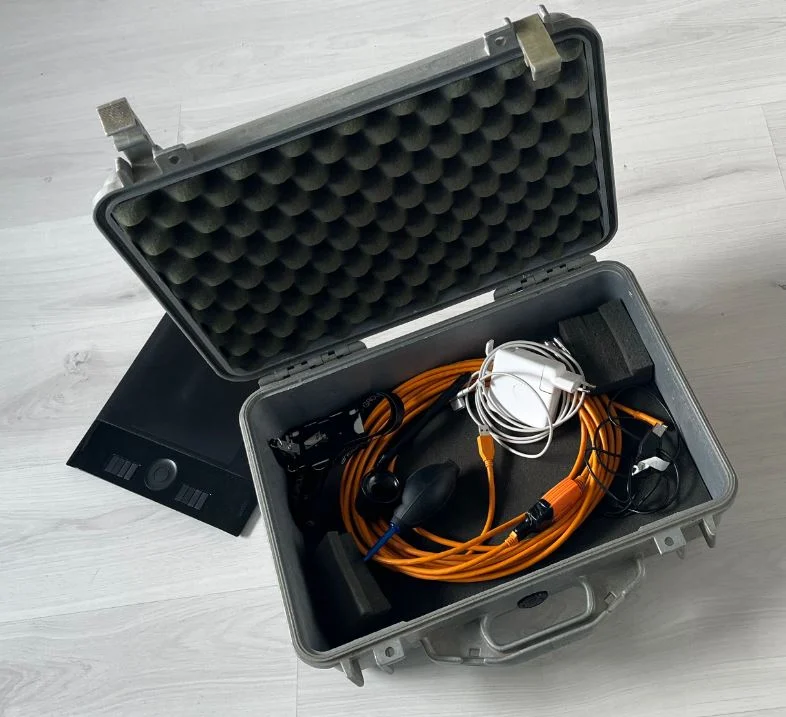In this case study, we examine how Peli Products’ Rack Mount Cases helped STRYDE, a pioneering land seismic technology and solutions company, in its pivot to design the best-selling Nimble System™ for subsurface imaging.
What is STRYDE?
STRYDE designs and manufactures the world’s smallest seismic imaging Node and accompanying Node management, charge, and data harvesting systems. Their systems deliver high-density subsurface imaging on land by using seismic reflection techniques. The Nodes are seismic receivers physically placed in the ground in the geographical area that is to be surveyed. A seismic source is triggered, and the Nodes record the data necessary for subsurface imaging. The Nodes are placed in a workstation that simultaneously charges the Nodes and harvests the data, which is managed through STRYDE’s proprietary software.

STRYDE’s seismic technology is used in many industries, especially those related to natural resources and renewable energy exploration such as Oil & Gas, Geothermal, Mining, and Carbon Capture Utilisation & Storage (CCUS). For organisations operating in these industries, it is important to assess the viability of potential sites for raw material extraction and energy generation so that informed investment decisions can be made. STRYDE’s nodal technology is also instrumental in identifying hidden hazards in civil engineering projects as well as for seismic risk assessment to minimise the impact of seismic natural phenomena.
Pain Points
What makes STRYDE’s systems unique are the Nodes, which are the smallest, lightest, and most affordable land seismic imaging Nodes in the world, and because of this, an organisation could utilise up to millions of Nodes in the field at a time, enabling them to acquire a better image uplift and survey much larger geographical areas at a much faster pace, at a significantly reduced price point.
Node management servers and hardware to charge, harvest, and manage the quality of the data obtained from the Nodes in the field are required to conduct the survey effectively, and therefore proprietary transport and protection cases were needed to house this hardware and technology safely.
According to STRYDE’s Chief Technology Officer Camille Lapierre, “Because STRYDE’s equipment is deployed across all 7 continents of the world, it was important to us to have our equipment transported in extremely robust and durable cases.”
Solution
STRYDE’s Nimble System™ is 1 of 3 nodal solutions created by STRYDE. Unlike the Pro and Compact Systems™ that are housed in containers, the Nimble System™ is a fully portable system that can be placed inside any office, workshop, or warehouse. The system is designed to manage up to 30,000 Nodes and contains a “System Case”, which hosts the workstation and software required to manage the Nodes, and up to 6 “Nest Cases” that charge and harvest the data from the Nodes within 4 hours. Therefore, procuring packaging that could fit each piece of equipment was required.
One important consideration for packaging was that STRYDE’s systems are often operated in remote locations all over the world, thus they needed packaging that could withstand the rigors associated with operating in the world’s harshest environments.
“When looking for natural resources, whether that be oil or water or minerals, they happen to be where these harsh conditions exist. […] It is normally, very, very usually in the desert, or in the frozen tundra in Canada for example, or the rain forest, very hostile environments, and that’s where our systems are designed to operate,” commented Lapierre.
Finding a case that could fit the Nimble System’s server was not a problem given its standard 19-inch width. However, the trickiest part of their search for a case had to do with the charging station. Also referred to as the “Nest,” this proprietary hardware that is used to both charge the Nodes and harvest the data from the Nodes was not standard in size, and consequently, finding a good fit proved to be difficult.

After scouring the market, Peli was identified as the only manufacturer that could not only provide the required level of protection for their system, but that could also accommodate the Nest. STRYDE specifically chose Peli’s Classic 19-inch V-Series rack cases. These cases are engineered to provide secure transport for rack mountable electronics because of the Wall Mounted Cylindrical shocks that are attached directly to the case wall, which isolate equipment from vibration as well as impact forces.

The Nimble System™ utilises two Peli rack cases: A 5U rack case for the System Case and a 7U rack case called the Nest case.
“We operate in snow, and in desert, [our systems] have been in the back of pickup trucks, driven around in rocky deserts, muddy forests,” commented Lapierre. Thus, it was imperative to find the right protective case for their needs. Indeed, Peli cases fit the bill.
Results
After bringing to market nodal systems with less cost and less hardware, STRYDE was able to further position itself as a leader in the market for seismic equipment. The resultant Nimble System™ has become STRYDE’s best-selling seismic system for subsurface imaging, and Peli’s Rack Mount Cases have been a key contributor to this success.
Lapierre concluded, “[The Peli Classic V Rack Case] has been a business enabler for us, to be able to transport these systems in Peli cases all over the world and in very challenging environments […] Even though the product was sold because we have been able to offer a small version of it, but to have a small version of it that we could carry around and that we could operate everywhere, we needed a ruggedised case, and we needed a ruggedised case in which our non-standard-sized system could fit […] Without the Peli case, we would not have had this small system, which made it possible to sell our Nimble System™ solution.”
If you would like to know more about how Peli can help you in your custom design project and achieve similar results to STRYDE, get in touch with Peli today at Peli.com.
To learn more about STRYDE’s seismic systems, visit www.strydefurther.com

